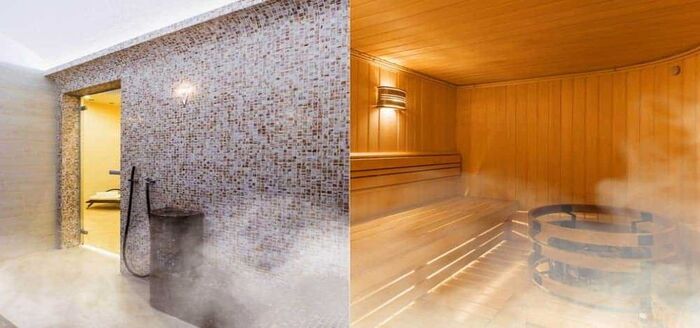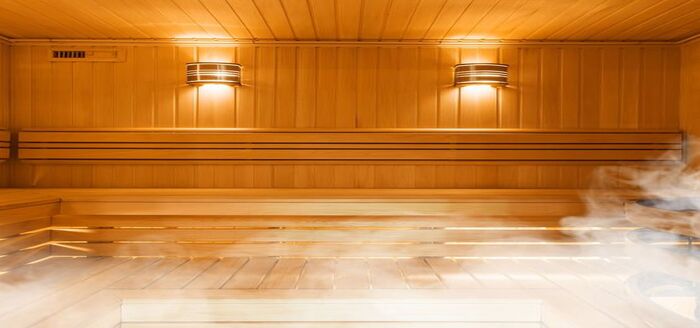Sauna Vs Steam Room After a Workout (Which One Is Best)?
I find that after working out, the sauna helps me rest my muscles, and the steam room looks more energizing and helps me breathe easier. After a difficult workout, the steam room and sauna are great places to unwind and relieve tired muscles. Although they are both small, heated areas that may be used either sitting or lying down, the main distinction between them is the kind of heat they produce: the hot room produces dry heat, while the steam room produces wet heat.
Additionally, there has long been a disagreement between steam rooms and saunas. Each has unique benefits, though they are similar. Use online maps or directories, such as Google Maps or Yelp, and search for “saunas near me” or “steam rooms near me” to locate saunas or steam rooms in your area. Let’s examine their distinctions if you’re curious about which one provides more health advantages.
The Similarities of Sauna vs Steam Room

Because of their high temperatures, the steam room and hot room also cause a rise in heart rate and blood circulation. Because of the increased heat, your heart has to work harder to pump blood to your skin’s surface, which cools your body and makes sure your muscles get enough blood. This procedure helps your muscles get more oxygen and nutrients while also providing a little aerobic exercise.
Furthermore, the heat’s ability to relax blood vessels might temporarily reduce blood pressure and ease painful muscles. Both circumstances cause a great deal of perspiration, which helps the skin and circulatory system get rid of pollutants. It’s crucial to remember that continuous exposure to heat in any environment can cause heat exhaustion, which can cause symptoms including dehydration and dizziness.
Read also: Add Sauna to MyFitnessPal (Tracking Burned Calories)
Difference between Sauna and Steam Room
Outdoor saunas produce heat using tiny burners called kivas. These heaters can be run on gas, electricity, or, less often, wood. They work by heating a pile of rocks, which either initially or continually release heat. Infrared saunas may go up to 40 degrees Celsius (or higher) hotter than steam rooms due to the ensuing dry heat. The high temperature, along with the dry air, causes a lot of moisture.
However, steam rooms generate “wet” heat—a high humidity level—using a generator from the outside that fills with water to produce steam. Individuals usually perspire more in steam rooms even when the temperature is lower because the condensation keeps perspiration from evaporating. This point promotes steam rooms above other detoxification methods. Furthermore, steam rooms are good for those with respiratory problems or blockages since they relieve the mucous membranes.
Steam room benefits

Here are the benefits of steam room use:
- Reduces congestion and facilitates breathing by releasing mucus and phlegm.
- Gradually relieves stiffness and pain in the joints, as well as muscular tightness.
- It temporarily hydrates the skin, but too much steaming might cause it to become dry.
When to use a steam room:
- After working out: To help with muscular relaxation and stretching, many athletes use the steam room.
- Pre-workout: The author, Safdar, goes on to say that adding a steam room visit to your routine before working out will help maximize your muscles’ range of motion and flexibility.
- As an element of spa expertise, it helps to open pores and encourage relaxation. Taking a seat in a steam room can be a good way to start your spa day.
Sauna benefits

Here are some benefits given below:
- Enhances calm
- Removes toxins
- Enhances blood flow
- Improves healing
- Increases immunity.
- Promotes the health of the skin
When to use a sauna:
- After a workout, the high temperatures of a hot room help speed up muscle healing and ease discomfort.
- As a regular health practice for longevity: Compared to research, using a sweat room at least four times a week can reduce the risk of heart disease mortality. This makes sauna use a regular health habit for a long time. Dry sessions can be combined with other ways to relieve stress, such as swimming in a cold plunge tub, to increase their effects.
- As a component of a calming regimen, warm saunas are the perfect place to unwind before bed or to begin the day with yoga because of their peaceful atmosphere. It might be beneficial to build a renewed mentality by spending a few minutes in the dry room practicing awareness.
HEAT THERAPY
An increased body temperature for an extended period is the goal of heat treatment. Here are a few heat treatment techniques that can do this:
- Conventional steam chambers
- Saunas using infrared technology
- Sheets for infrared saunas
- Conventional saunas
- Warming pads
- Warm bathtubs
- Ultrasound therapy
Heat treatment has shown promise for improving several health markers and producing many kinds of health benefits. These include improved insulin sensitivity, decreased weight gain, beneficial effects on the heart and circulatory systems, muscular relaxation, relief from back pain and discomfort, and enhanced memory.
Heat of a sauna for muscle recovery
Numerous studies demonstrate the advantages of exposing muscles to heat following physical activity. The following benefits of heat rooms have been scientifically proven:
- Reduces the damage to muscles after exercise.
- It relieves DOMS and delayed-onset muscle soreness.
- Increases blood volume, which boosts weight reduction and improves future physical performance.
- Slightly increases post-exercise calorie expenditure, which aids with weight reduction.
- It relieves chronic pain resulting from arthritic diseases and past muscular traumas.
- It widens blood vessels, which speeds up the removal of pollutants and metabolic waste products.
Sauna Vs Steam Room: Better one
Choosing a sauna over a steam room after working out might be somewhat more beneficial if your main objective is to optimize the advantages. The majority of these sessions’ benefits are derived from the extreme heat, so it makes sense that the hotter option would have more benefits. Heat encourages higher blood flow to the muscles, which makes it easier for nutrients and oxygen to reach them and speeds up healing.
Additionally, the higher heat promotes hyperthermic conditioning and momentarily increases the rate of metabolism. The decision between a sauna and a steam room ultimately comes down to personal taste. The humidity in the hot tubs could be too much for some people, and the dry heat in the dry room might be too much for others.
Read also: DO YOU SWEAT MORE IN A SAUNA OR STEAM ROOM?
FAQs
The most frequently asked questions are given below:
Is it better to use a sauna or steam first?
Although there’s no hard-and-fast rule about which is better to use first, some individuals would rather use the steam room last and the dry room first. Have one or two glasses of water, and take a shower when you enter the dry room. For a maximum of ten minutes, stay warm in the dry room without adding any moisture.
Which is better, the sauna or the steam room, for the skin?
The heat of steam rooms and saunas will cause one to perspire. Sweating facilitates pore opening and external skin cleansing. Warm condensation may aid in the treatment of pimples by cleaning away impurities and dead skin. A steam room, however, also aids in eliminating toxins that are trapped behind the skin, unlike a sauna.
What’s better for weight loss: a steam room or a sauna?
Saunas have a significant impact on weight loss by regulating lipids like fats and cholesterol. Both a dry room and a steam room can help with muscle healing. Saunas are frequently chosen as the favored weight-loss option since many people believe they offer greater health advantages overall.






